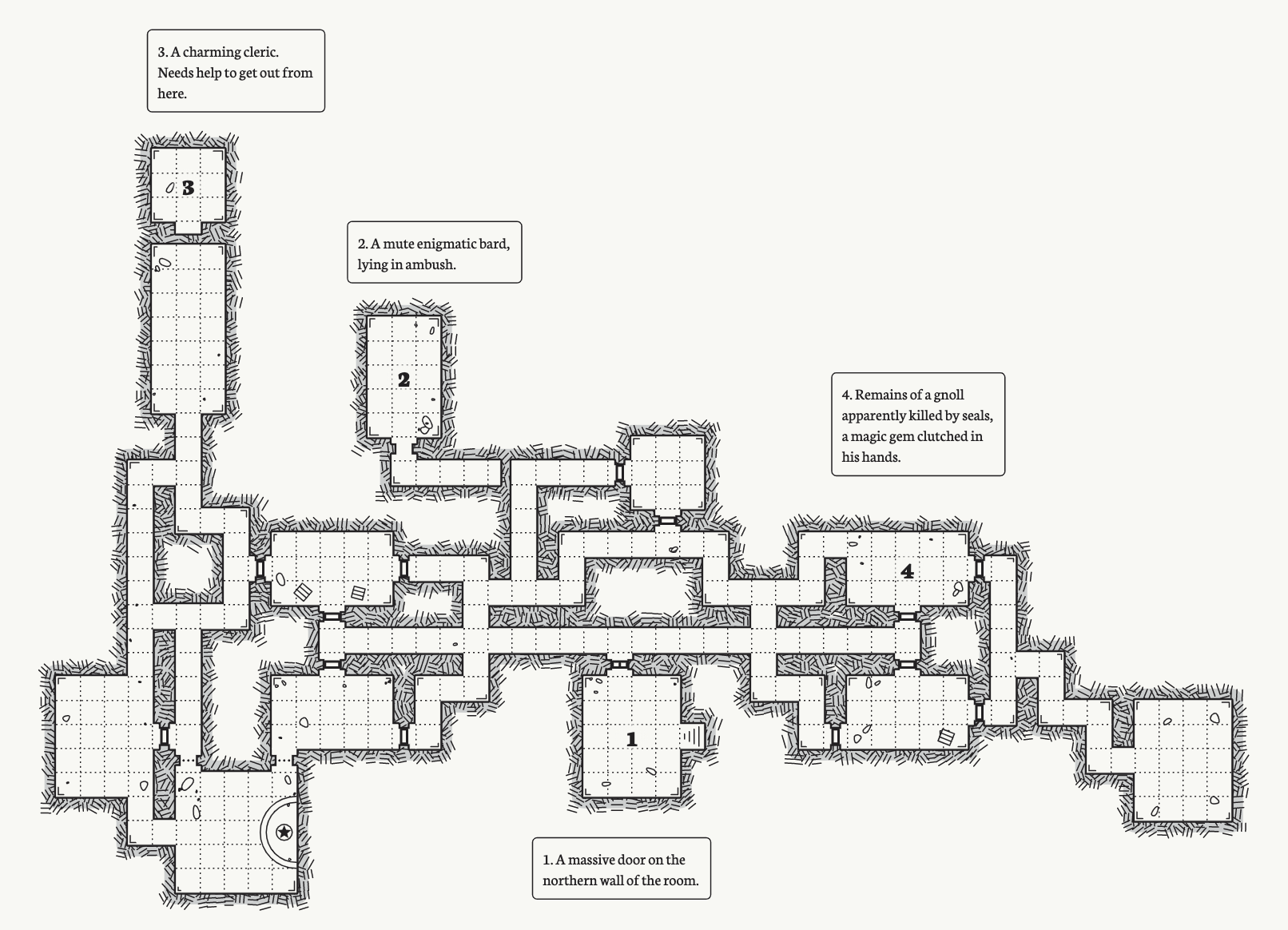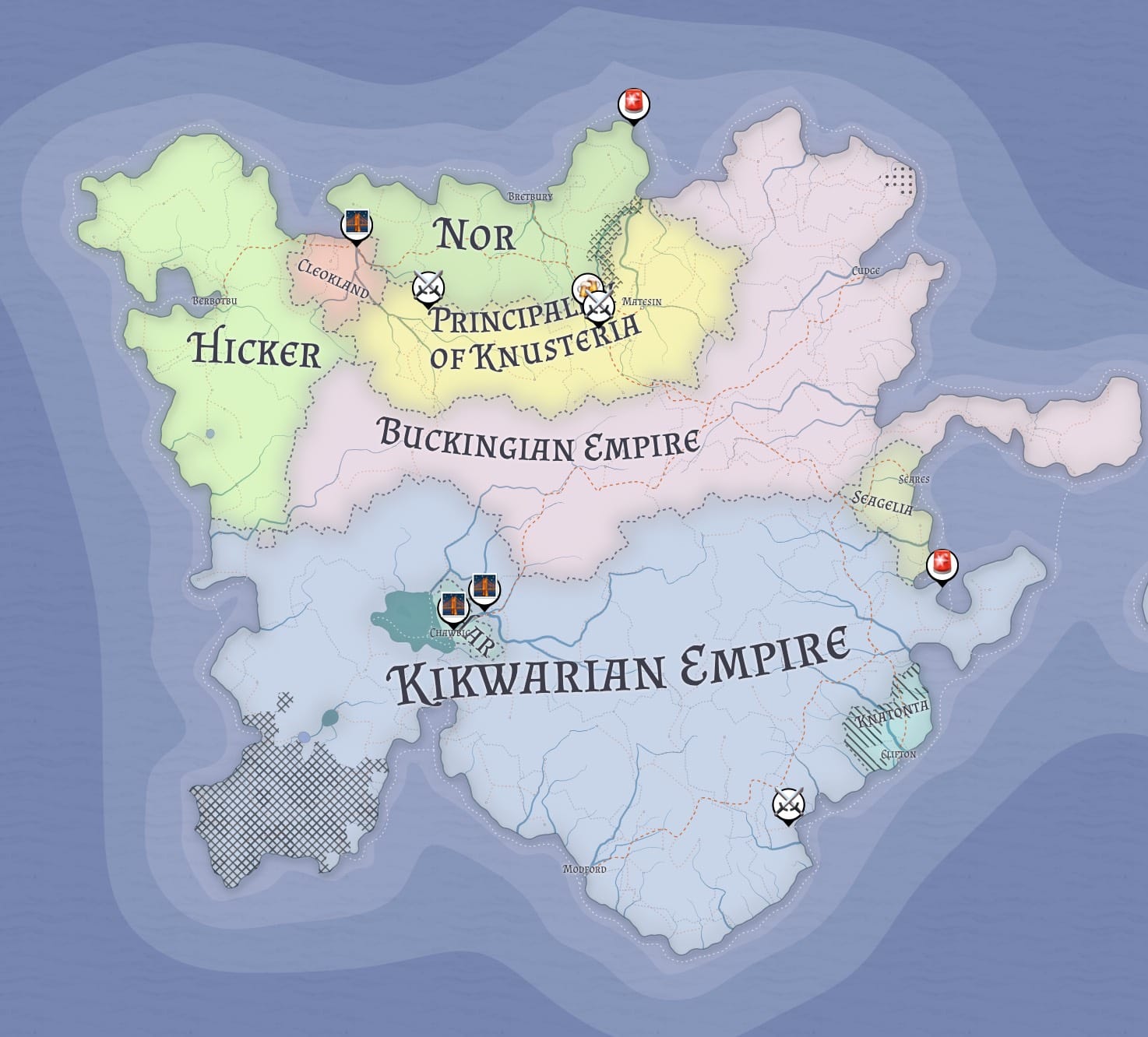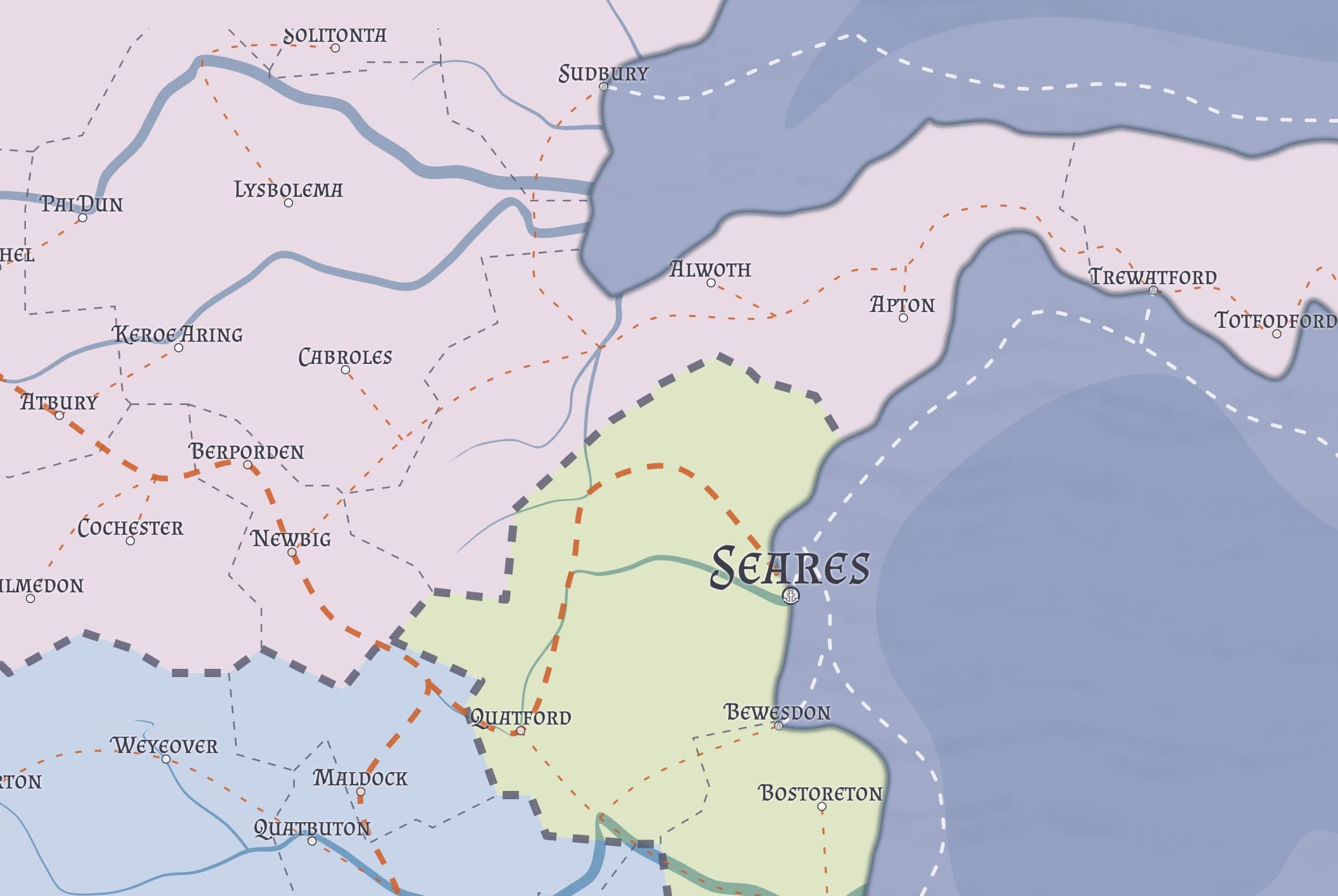By limbeck
Things have progressed more smoothly in this session, with a bit of excitement and a lot more exposition. I finished the previous one after getting a quest from Mr UNDERHOUSE to get a diary from the Mayor's safe and with Miss PICOTT vehemently refusing to give me her Bible. I need the Bible to find the aforementioned safe's combination.
No amount of talk seems to change Miss PICOTT's mind, so I leave her and do some more walking around. My wanderings bring me to MYER's shop again. He obviously does not mention WILBUR or keys casually left on counters, but he gets to what he knows best: business. He tells me he received a lot of nice new goodies overnight, such as a cheap locket, an even cheaper brooch and more photosensitive plates. I buy the lot, because I still have access to Mr GRIFFITH's funds. I feel quite satisfied with my purchase, but as soon as I get out of the store, the pin falls off the brooch.
 |
| I have been scammed! |
I go immediately inside to ask for a refund, but MYER just acts as if everything is in order. I decide to roll with the punches and see the positives. The pin I now have in my inventory may still be used to pick a lock. Not the one in the cemetery though.
I pay a visit to CURTIS's shack, but he is not in. I wonder if he is dead, like poor JUGG. In the tavern, ZEKE again offers me some of his water for beer and mocks me when I don't buy one.
 |
| Sorry, I just spent $3 on a broken brooch and a fake silver locket. |
I then go to the pharmacy and order three more pills, just to be on the safe side. I have money and I want to be alive to spend them. Dr COBBLE was seen leaving the pharmacy but I could not interact with him. It is nice that the NPCs seem to follow their own schedule. It is not critical to gameplay, but it is a nice touch. They are simple actions, but most of them are realistic and help with the immersion and the feeling that you are indeed in a living town.
Further down, I come across BISHOP outside of the Archives. I approach him and try to talk to him about TYLER, but he gets scared and says he indeed has something to tell me, but at a place and time to be determined later. With that, he leaves.
Finally I am back in front of the post office and in the company of Miss PICOTT. I try to give her the brooch, but she is offended that I try to "buy her respect" with worthless shiny baubles. I double my bet, offering her the $2 locket instead of the $1 brooch and she happily accepts and trades me her Bible for it.
 |
| Just before I propose to Miss PICOTT |
Reading the Bible, I get three options:
- Austin, errr John 3:16 from Saint PAUL's epistles
- Peter doing something in front of some 120 people from the Acts of Apostles
- The Number of the Beast from the Apocalypse
Well, we needed a number that symbolises evil to open the Mayor's safe. I am pretty sure that the Number of the Beast fits that role perfectly. But we first need to get to the safe. The Mayor is rarely at his office, which is good, but access to it is forbidden by his very diligent and busy clerk. So, I go to the Town Hall ready for a confrontation with a clerk.
 |
| He seems to have called in reinforcements |
I arrive just in time the annual town hall clerk conference or it's just lunch break. When I try to talk to anybody, I find out that I am facing a dialogue puzzle. It takes me a few tries to get it right:
- I first tell that I need to go to the Mayor's office (yes, in his absence)
- Then I try to bluff my way in and tell him that the Mayor himself invited me to admire Illsmouth from his window. The clerk, Mr SWING, swallows it hook, line and sinker and concludes that I am the photographer.
- I correct him that I am a reporter and I am free to walk upstairs.
I walk in the Mayor's office. There's nothing interesting in it apart from the safe, hidden behind a painting.
 |
| Not that hard to spot if you want my opinion |
I open it and get to the task of opening it. I am presented with three slots with very slowly sliding numbers. I put 666 and hope for a satisfying click, but I am disappointed. Apparently the Number of the Beast itself is not evil enough. I try a couple more times and I get arrested.
I try again after reloading. I suppose I am given three tries to get it right (or infinite with reloading). I must note that the Bible is not working any more, so I should have noted down what I read.
 |
| A screenshot would also work I suppose |
After a bit of thought, I put the page number in the Bible, where the number of the Beast is mentioned. So, either all Bibles have the exact same layout or there is just the one Bible in town and they pass it around. Either way, it doesn't really make much sense as a solution, but I only had a few options, so I will not complain much.
When I open the safe, I find a diary and a cigar case. I take both. But now that I have the diary, I find that I cannot give it to UNDERHOUSE or use it. UNDERHOUSE in particular congratulates me for taking it and then tells me to put it back where I found it.
 |
| Was this some kind of initiation challenge? |
I am seriously confused this time, so I walk around the town again. The fact that all NPCs are still where I left them indicates that the scene I am playing in has not yet changed. I have noticed that once I reach a milestone, all NPCs just move to different locations. Walking around this time just gives me the same dialogues.
I do come across CURTIS and GREENWOOD (the blind man) walking out of the latter one's house and into the forest. I follow them, but I lose them as soon as I enter the forest. Are they buddies from old out for a walk?
While in the forest, I decide to try and use the cigar case. Nothing happened there. I focus on the 'there', because as soon as I return to the village, PARKER takes initiative and unscrews the case. Inside it is a deposit note. I head to the post office, but I cannot use it. I return to the Mayor's office and now I can read the notice! It is about a parcel delivery under WILBUR's name. Reading of the notice IN the Mayor's office make me think that I can only read the diary in there. I am correct. I sit on his desk and receive the first batch of exposition for the day.
 |
| I am not that interested in you, JONAS. Feel my indifference |
The diary belonged to JONAS HAMBLETON, father of WILBUR and CURTIS. JONAS made his fortune at sea and signed an unholy pact with NARACKAMUS and an ancient god of the sea, named Dagon, in exchange for immortality. He sacrificed or offered (it's not clear) his wife to that foul being and in return, he got his two sons. JONAS claims that some plans of theirs were foiled by BOLESKINE, but he also says that time means nothing to him and the stars will be right again. WILBUR has the gift of "begging to the stones", whatever that may mean. JONAS's burial place is where earth, sky and water come together. Could that be a beach or something? Finally, he speaks about some families (four in number) and the same number of statuettes, which he guards in his crypt. According to my journal, I need to find these 4 statuettes and wait for the comet to pass to stop those 4 families. I must say that the narrative during the cutscene could use some improvement. It was too dry and not up to Lovecraftian standards. Anyway, it seems as if JONAS is still alive.
 |
| Thanks for the hint JONAS |
After reading the diary, I put it back in the safe and walk to the post office, a bit shaken I must admit. Miss PICOTT and CYNTHIA are gone from the front of the post office, which signals that something has changed in the game. I've reached a new milestone.
Walking to Ms WEBSTER at the post office counter, I give the notice for WILBUR's package and she hands me the package without many questions. Now, I would find that very funny if I had not had some horrible experiences with the post service here in Ireland recently. Anyway, I wonder why the Mayor would keep WILBUR's delivery notice in his safe.
The parcel contains a frock, like the one that WILBUR wears. He only buys his ritual cloaks in Boston I am told. Later, I meet Mr COLDSTONE, who offers me a drink at his house. I hadn't saved for a while, so I decline, but I am sure this would be another death scene. One of my responses could have been that I was going to the Lighthouse. Why would I go there? Is it where JONAS's tomb lies? Maybe I'll take the not so subtle hint and go there. At least I have the proper disguise for it.
 |
| But closed minds prevent me from putting it on |
Before I visit the lighthouse though, I decide to go to the cemetery, in case the tomb is there. On my way I meet Mr BISHOP, who offers me his help, as he believes I have come to lift the curse that haunts Illsmouth. I also learn that the HAMBLETONS are out for me. I still cannot get in the cemetery, so I head to the lighthouse.
Whenever I try to put the frock on in the open, I am interrupted by the locals (in one case CYNTHIA, who threatens to call the police). For me this is a nicely executed comic relief in the game. I go to my room, but still cannot change there. Sometimes you just can't get rid of a bomb.
After failing to set myself free of the conformism that clothes bring, in various locations, I succeed to change behind the well and only behind the well.
 |
| Modesty for the fourth wall |
I then go to the gate for the lighthouse, which is guarded by the two gorillas. I grunt at them when given the option and they let me pass. I suppose being more articulate would give away that I am not WILBUR.
At the base of the lighthouse, I take the frock off and try to find a way in. With the door locked, there is only one way in and that is through the window, by using the rope ladder I had picked up very early from outside CURTIS's place.
 |
| Have I mentioned already how deep in the uncanny valley these cutscenes lie? |
I run to the top of the lighthouse, where I realise that the two goons were not fooled for long by my disguise and are after me. I lock the door to the balcony, but something tells me that I am again in a time-constrained puzzle. Fortunately I only have a limited number of objects to use and interact with. A sundial has a mechanism which opens and reveals a set of wings. There is also a lamp that has a candle in it.
If I try to use the wings, I fly off the balcony and crash to death like a proper idiot. Fortunately I happen to recall the myth about the flight of Icarus, who flew too high and the sun melted the wax that held his wings together. Now, if only I had a source of wax... I take the candle and place it on the ground. I try using the wings again, thinking that I would use them on the candle, but the candle is not lit and I get a Wile. E. Coyote death again.
Third time is the charm and this time I first use my magnifying glass to light the candle and use the melted wax from it to strengthen the wings. I can then use the wings to fly safely away and land in the middle of the gypsy camp in the forest.
 |
| The lighthouse is far to the right, but I seemed to fly in from the south. |
It was satisfactory to solve this puzzle, simple as it was. I like it when I can use an item multiple times during a game. In this case, it was the magnifying glass. I don't expect a sonic screwdriver or a passe partout, but I see no reason to discard potentially useful items after using them only once in a puzzle.
On the other hand, the whole lighthouse sequence didn't really make sense. I learned nothing out of it and it only progressed the plot in a ridiculous manner. Who keeps a set of wings on top of a lighthouse? Why couldn't I just find the gypsies just by wandering through the forest? Why did I want to go to the lighthouse in the first place?
Back to the gypsy camp, I speak to the fortune teller, who is the only person or thing I can interact with, and I am treated to my second exposition sequence of the session. This one features Lord BOLESKINE himself, who tells me that I have to repeat what he did 76 years ago and stop the cult of the Ancient Ones (and get mad in the process I suspect). All the exposition is given in a nicely stylised scene in ochre tones. I liked this one better than JONAS's diary.
 |
| It can also be used as a puzzle screen for Gobliins 2. |
Lord BOLESKINE tells me that Illsmouth was built where an ancient temple used to stand. A temple, in which horrific sacrifices to the Ancient Ones were performed by a sorcerer. When the comet passes in two days, I will have to stop their unholy plan to bring those extradimensional horrors back to Earth. What I must do is go to where JONAS HAMBLETON is buried, which I assume must be in the cemetery.
It is night again when I get out of the forest and head to the cemetary. Outside of the pharmacy I meet Mr BISHOP again, who tells me that Dr COBBLE has proclaimed JUGG's death a suicide, but he does not believe it. I don't believe it either. BISHOP seems as if he wants to run away, but he also mentions a cemetery key. I ask him for it and he gladly lends it to me. I'll next go to the graveyard, but I want to have a quick walk around first, because the scene has again changed and I need to be sure I have not missed something.
I feel vindicated. In front of MYER's shop there is some rotten fish in the bin. I pick it up to cover my own smell of fear.
I use BISHOP's key and I enter the cemetery, which I must say is very nicely drawn.I see a light at the keeper's house, but I'd rather ignore it for now. Wandering around, I pick up a bar and a piece of rope. I also notice some named tombs: PRATT, ELIZABETH SULLIVAN, BELLA BLASKO, but I cannot see any use for them. So, I ignore them and go in the crypt, which has even nicer artwork.
 |
| Artwork from cemetery and crypt. I like the use of colours |
The gate to get deeper is barred, but nothing that a good iron bar cannot open. Of course I drop to my death again, because I forgot to tie the rope and use it to climb down. Once I do so, I arrive at the beginning of what I remember was a horrible maze.
I will stop the session here with the realisation that I never went to pick those three pills from the pharmacy. I hope I will not come to regret it. I expect a full showdown in the next session, which will result in insanity or, if I am lucky, in my death.
Session time: 1:40
Total time: 7:40
Sanity lost: 5 from the double exposition
Total sanity lost: 17 (I need more candles. Leave no shadow alive. I can still hear that violin from under the bed.)
Note Regarding Spoilers and Companion Assist Points: There's a set of rules regarding spoilers and companion assist points. Please read it here before making any comments that could be considered a spoiler in any way. The short of it is that no points will be given for hints or spoilers given in advance of me requiring one. Please...try not to spoil any part of the game for me...unless I really obviously need the help...or I specifically request assistance. In this instance, I've not made any requests for assistance. Thanks!





























